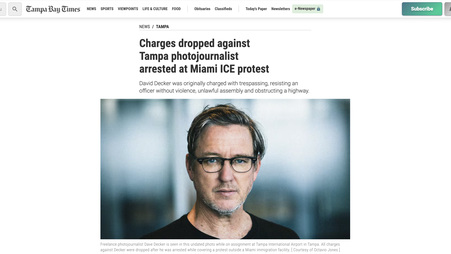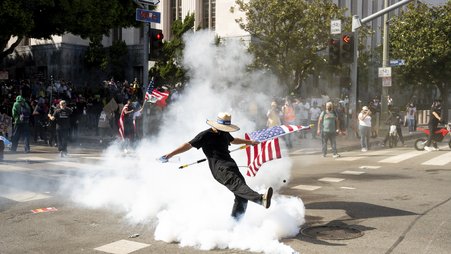Even when police can disperse protesters who break the law, they can’t disperse journalists along with them. And it follows that they can’t arrest journalists for not complying with orders to disperse that were illegal in the first place.
That shouldn’t be news. Appellate courts have said it. The Department of Justice said it in its reprimand of the Minneapolis Police Department for its crackdowns following George Floyd’s murder. But, as we saw at the Democratic National Convention in Chicago, police departments haven’t gotten the message.
That’s why it’s so important that the DOJ is now saying it louder, in a new guidance containing recommendations from the department and the Police Executive Research Forum for police-press interactions at mass demonstrations. We should note that our friends at the Reporters Committee for Freedom of the Press were instrumental in making this happen.
Here’s some key language:
“In the case of mass demonstrations, there may be situations—such as dispersal orders or curfews—where the police may reasonably limit public access. In these circumstances, to ensure that these limitations are narrowly tailored, the police may need to exempt reporters from these restrictions, and under those circumstances, they will need to determine who they consider to be members of the media. Because this can be challenging in chaotic moments, it is recommended that police err on the side of inclusiveness, defining as “media” both credentialed press from established media outlets and noncredentialed individuals who are acting as reporters in their function and behavior.”
That seems clear enough. And it’s the perfect opportunity for prosecutors with open cases against journalists for failing to disperse to drop them.
Here are a few prosecutors who should jump at the opportunity to do the right thing. We’ll send them a copy of this article to make sure they’re on notice. Readers, feel free to do the same.
Cook County, Illinois, State’s Attorney Kim Foxx: According to the U.S. Press Freedom Tracker, a project of Freedom of the Press Foundation (FPF), cases remain pending against at least three journalists arrested during the DNC in August — Sinna Nasseri, Olga Fedorova, and Josh Pacheco.
None of these journalists are accused of doing anything illegal except not obeying police orders to disperse. The Chicago Police Department knew that was not a reason to arrest journalists — we warned them in the newspaper and on the radio. They were so confident they knew what they were doing that they declined offers from the National Press Photographers Association to train them on exactly these kinds of issues.
But they didn’t know what they were doing. In fact, CPD Deputy Director of News Affairs and Communications Tom Ahern went as far as to threaten to revoke journalists’ press credentials if they didn’t comply with his illegal orders. He even ripped credentials off reporters’ necks.
Foxx shouldn’t wait a minute longer to end this embarrassing ordeal and drop charges against any journalist arrested for doing their jobs at the DNC. And Ahern should resign. His conduct was inexcusable (check out the conversation we hosted last month with independent journalists who saw it firsthand, including Fedorova).
Multnomah County, Oregon, District Attorney Mike Schmidt: Journalist Alissa Azar was arrested while covering a pro-Palestinian protest at Portland State University on May 2, 2024. She’s accused of nothing other than not dispersing, and video of the arrest appears to confirm she wasn’t breaking any laws (note that this arrest has nothing to do with Azar’s recent conviction over an entirely separate incident in 2021).
We wrote a letter to Schmidt, joined by other leading press freedom organizations, but heard nothing. Schmidt should not need the DOJ to tell him the case should be dropped — the 9th Circuit Court of Appeals, which has jurisdiction over Oregon, has made clear that police can’t include law-abiding journalists in dispersal orders. Schmidt has also seen other Oregon officials get embarrassed and sued after pursuing unconstitutional cases against journalists. It might be too late to avoid a similar outcome but the DOJ guidance gives him a chance to at least mitigate the damage by dismissing the charges.
Ulster County, New York, District Attorney Emmanuel Nneji: Journalist John Camera was arrested on May 2 while covering a protest at the State University of New York at New Paltz. The protest escalated, and he was arrested by state troopers, along with 132 others, when he allegedly did not disperse on command.
One of the troopers told the Tracker he expected the charge to be dropped — so why bring it in the first place? These kinds of catch and release arrests serve no purpose except to censor journalists by removing them from the scene of the news they were covering.
That calls to mind another important recommendation included in the DOJ report: “Once the journalist has established they were acting as a journalist and were inadvertently or improperly detained, officers should be directed to quickly release the individual without charge.”
St. Lawrence County, New York, District Attorney Gary Pasqua: Isaac White, a reporter for Indian Time, was arrested while covering a demonstration on New York’s Barnhart Island this May. Even though he’s accused of nothing but failing to follow an illegal dispersal order, he’s facing charges of both trespassing and conspiracy, along with numerous protesters who were arrested along with him. To the best of our knowledge, his alleged “conspiring” doesn’t involve anything more than being present at the protest.
White told the Tracker that when police ordered him to disperse they didn’t tell him where he could go to keep doing his job. That’s a common problem. The DOJ report explains that, in the exceedingly rare event that police can constitutionally disperse a journalist because there’s no other way to mitigate some kind of public safety threat (and we’re aware of none in White’s case), they’re obligated to provide an alternate location from which the journalist can report.
And that doesn’t mean they can send journalists to the cheap seats — it has to be somewhere they can see and hear what’s going on.
Buncombe County, North Carolina, District Attorney Todd Williams: Asheville journalists Matilda Bliss and Veronica Coit are appealing their conviction for violating a park curfew to document police evicting a homeless encampment at a public park.
We’ve repeatedly noted the absurdity of Wiliams’ position that journalists can be barred from covering obviously newsworthy events, in plain sight and on public land, just because it’s dark out. And now the DOJ has agreed — law-abiding journalists cannot be subjected to curfews when attempting to do their jobs.
Williams’ office stubbornly pursued the misdemeanor case through a jury trial, costing local taxpayers significant money to punish the press. And there is evidence of retaliation against Bliss and Coit specifically that, under recent Supreme Court precedent, could subject the city and its officials to legal liability. That’s the last thing Asheville needs after Hurricane Helene.
Alameda County, California, District Attorney Pamela Price: Journalist Yesica Prado was arrested while reporting on a homeless encampment cleanup operation in Oakland, California, in September.
She questioned officers who had ordered her to report from behind a fence where she couldn’t see, and then was threatened with arrest — and use of force — for being in a “safe work zone.” Officers then followed through on the threat.
As a coalition of press freedom organizations, including FPF, explained in a joint statement, the First Amendment (not to mention California law) does not permit declaring a large area where news is happening a “work zone” or “crime scene” in order to expel the press.
It’s no different from dispersal orders or curfews — even when these designations can properly be invoked for public safety reasons, journalists should be exempted or, if absolutely necessary, given a viable alternative place to report from.
Prosecutors: Now’s the perfect time to drop these charges. You can even save face by claiming you changed course in response to the DOJ’s new guidance (although, just between us, you should have known they were unconstitutional from the outset).
Note: While the new DOJ guidance includes a disclaimer that some of its content may not represent the official position of the DOJ, it’s safe to assume that the discussion of not dispersing journalists does, given that the DOJ has taken identical positions in official reports.





